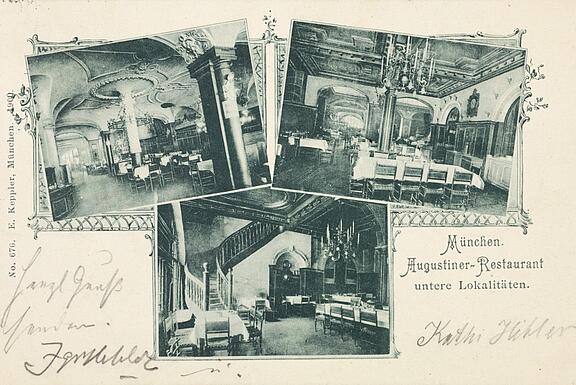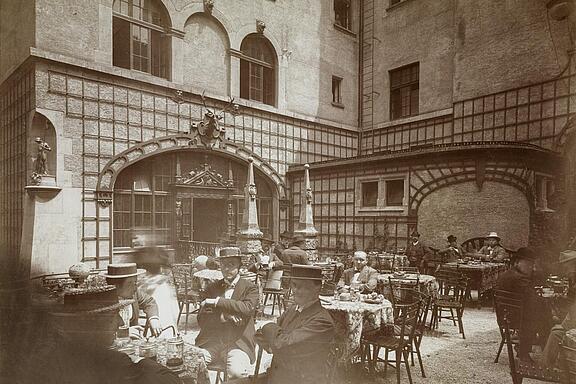History
Dear guests,
the history of the first Augustiner original building goes back to the end of the 13th century. To be exact back to May 4, 1294, when the cornerstone for the Augustinian monastery on Haberfelde was laid on “Neuhauser Gasse”.
The year 1328 is of double importance for the Augustiner brewery. So it is documented that the monks already operated a brewery at that time. This in turn means that the Augustiner brewery is the “Munich's oldest brewery”.
1372 - 1600
11500 people lived in Munich, and there were already 21 brewers in 1372. A few decades later, in 1502, there were 39 breweries in Munich. And in 1600 there were 74 breweries - plus six monastery breweries - which of course included the Augustiner brewery. So while the number of breweries almost tripled in almost two centuries, Munich's population rose to just 18000.
1784
January 16, 1784 - since the Augustinian monks were said to have repeatedly poured beer inside and outside the monastery, the brewers complained to the council. The monks were said to have even set up a dining room. The administration was non-indulgent that time, which was proven by the fact that the Augustinian monks were threatened with a penalty of 100 ducats or destroy of the brewing kettles in the event of repetition.
What is interesting about this, however, is that until 1589 the Dukes of Wittelsbach themselves diligently ordered the highly valued, strong beer from monks. Only after they had started brewing their own beer, they stopped getting supply from monks.
1791
In 1791 Elector Karl Theodor publicly reprimanded the Augustinian monks. He had heard that their beer flowed freely on site and that some monks could no longer fulfill their spiritual duties. The baker’s servants used the brewery, which now had the right to serve beer, as a meeting place. It was also highly valued by locals and foreigners for its conviviality and cosiness.
1802 - 1803
Around 1802, secularization came into full effect in Bavaria, which resulted in numerous monasteries being abandoned and the property transferred to the ruling house or sold. In 1803 it also hit the Augustiner monastery. The brewery was run by the state for a few more years.
1817
In 1817 the Augustiner brewery moved urgently to the new original building, directly in Neuhauser Strasse 16.The new owners and landlords, Georg Gröber and Baptist Lankes, both professional fishermen, did not have any idea about beer brewing so that another change of ownership happened twelve years later. However, this event influenced significantly the brewery's destiny.
1829
On March 5, 1829 Anton and Therese Wagner, a seasoned brewing couple - Freisinger Hagenbräu - took over the Augustiner Brewery. From then the Munich's oldest brewery has continued to be privately owned. The beer was very popular and ensured a flourishing business, which led to the fact that the neighboring houses were bought and the old brewery was enlarged.
1844
In 1844 there was grief at the death of the brewer Anton Wagner. From then on, Therese Wagner was at the head of one of the most important Munich breweries. She made a significant contribution to keep things going on. So in 1845 she took over the neighboring Unterkandlerbräu.
1852
Therese Wagner was an entrepreneur with visions, so in the summer of 1852, here in the second Augustiner original building, she had a new brewing plant set up with a steam engine and boiler. This step completely changed beer production, from handmade to industrial beer.
1857 - 1858
But it quickly became very narrow on Neuhauser Strasse. So she acquired the Butler cellar in 1857. At that time it was outside the city, on Landsberger Strasse. The successful survival of the brewery and the beer hall was assured. A year later, in 1858, Therese Wagner died. The eldest son Joseph took over the successful business.
1883 - 1890
Under his aegis, the site of the former Butler cellar - from 1883 to 1890 - developed into a state-of-the-art brewery. At the same time, this meant that beer production gradually moved from the narrow city center to Schwanthalerhöhe and the Augustinian original building was increasingly transformed into an inn.
Have you already known?
The entire ensemble of the Augustiner brewery (Landsberger Straße 31–35) is the completely preserved Munich brewery from the 19th century.
1895 - 1897
With the move of the classic brewery, a new chapter in the history of the Augustiner original building began. In 1895, none other than Emanuel von Seidl was commissioned to redesign the entire complex of houses on Neuhauser Strasse 22. From 1896 to 1897 a new beer serving building with an inn was built on this site, which became famous under the names "Zum Augustiner" and "Augustiner Großgaststätten".
Have you already known?
The Munich Emanuel von Seidl (1856-1919) was considered as one of the villa architects in southern Germany. His buildings include the Seidlvilla as well as the Elephant House in Hellabrunn Zoo. His first remarkable piece of work was the legendary Muschel (Seashell) hall of the Augustiner original building, created in 1897 - which you can still admire today.
1972
1972 Summer Olympics in Munich, the city gets its first pedestrian area. This gives the Augustiner original building, in addition to its beautiful arcade garden, a second free bar area in the middle of the city.
1984
We, the Vollmer family, have been a leaseholder of one of the most traditional inn in the Bavarian capital since 1984. For us, the almost 200 –year-old second Augustiner original building is far more than just an inn. It has also become a part of home. That is why we feel deeply committed to the tradition of the house as well as the often-praised Bavarian inn culture.





